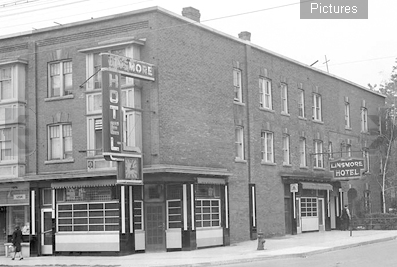Seems the more you study the mysterious spelling discrepancies surrounding this Greenwood-Danforth street, the less certainty there is
This story was first posted at OpenFile.ca on March 22, 2011. So far, the city hasn’t made a decision on which spelling(s) will be used when it replaces the street signs. But since 2013, the Linsmore Tavern itself has taken on new life, bringing in lots of great live music and packing the place on weekends.
By STEPHEN WICKENS
If Sharron Maurice has her way, neighbours from Linsmore and Linnsmore crescents will celebrate their differences at her bar when the City’s new street signs arrive.
For 25 years, Maurice has managed the Linsmore Tavern, a fixture since 1934 at Danforth Avenue and Linnsmore Crescent. Steps from Greenwood subway station, it offers inexpensive beer and a friendly retro taste of Toronto, though it seems an unlikely spot for picky spellers. But Maurice, like her dad before her, has taken a stand. She’s firmly in the one–N Linsmore camp, even if the City says that the street starting outside the door gets two Ns — at least up to the old pre-amalgamation East York boundary, between Springdale and Milverton boulevards.

“I can’t say it’s a regular hot topic,” she says, “but the one-N/two-N thing has come up many times over the years — decades actually. People come in and ask, ‘Did they screw up or was it you?’”
“We’re right; we have the original papers,” Maurice says, adding that the tavern predates the spelling squabble and the old black-on-white street signs, which some say triggered the dispute nearly eighty years ago.
For now, the official view is that century-old subdivision plans establish two Ns as legally correct in old Toronto, while East York Township bylaws from a few years later make one N legitimate on the street’s northern part. Allen Pinkerton, City Transportation Services’ manager of signs and markings, can’t think of another Toronto street that changes spelling partway — in this case, between Nos. 99 and 101 on the east side and 100 and 102 on the west.
The City, meanwhile, says it won’t rush to roll out new signs. That might be wise, because the document cited as proof that two Ns are right for lower Linnsmore either raises new spelling questions about other streets or casts doubt on whether the person who produced the plan could spell in the first place. The version of plan 509E at the City Registry does spell Linnsmore with two Ns, but it shows neighbouring Glebeholme Boulevard without a third E. It also spells boulevard “boulevarde” in four cases.
Wally Kowalenko, Toronto’s director of surveying, scratches his head, literally, when the discrepancies are pointed out. “We try to steer clear of the subjective,” he says. “The registered plan, a lawful document, created the street. If it contains a mistake and the municipality wants to fix it, it can pass a bylaw.”
Residents tend to offer both spellings because cabs, delivery people, utilities, emergency services, and City departments don’t always recognize their first choices. Nobody we spoke with recalls any life-threatening cases of confusion, but Filis Lamanna at No. 56 says puzzled police were delayed once on a burglar-alarm call. Paul Robinson at No. 91 almost backed out of a house purchase upon learning a two-N address is outside the coveted R.H. McGregor school territory.
Linnsmore resident Evelyn White says she’s heard some Linsmore residents view two-N folks as snobby, but we couldn’t find any who would say so — on the record.
“Snooty and illiterate, actually,” said a one-N senior who laughed, wouldn’t give his name, and said he was only joking.
Most on Linnsmore like the extra N, with two residents we spoke to saying it looks better, even if it might be wrong. A few say signs north of the East York line and on the tavern must be typos. Others like the quirkiness of dual spellings.

Nearly all, no matter how they spell it, want to know how the dispute began. City directories, which aren’t legal documents, show Linnsmore with only one N till 1936, and two thereafter. That says nothing about whether a mistake was corrected or created during the Great Depression, but it fits the prevailing theory at the Linsmore Tavern and that of a red-haired woman who wore a Blue Jays cap at a 2008 Danforth East Jane Jacobs walk. Both say they’ve heard there was “an uproar” when signs with two Ns arrived in the mid-1930s. “People complained about the typo, but the City didn’t do anything,” said the red-haired woman, whose mother grew up on the street.
In newspapers, Linsmore has one N in the Globe until 1935, and a mixture afterward. The Star goes with one N in a colorful 1934 story about teetotalers horrified that the Linsmore Tavern was granted a licence (“the hideous blotches called hotels,” said ex–board of education head Loftus Reid). After 1936, double-N is the most common Star spelling.
In City tax rolls, two Ns first appear in 1957, but only in the index. Double-N is uncommon till the late 1970s. By the late ’80s, single-N disappears, but try double–N in the post-amalgamation database at the archives and you’ll get an “invalid address” message.
Sharron Maurice and one of her neighbours say Linsmore is named for “a lord or a castle in Britain.” There is a Linsmore Lodges that rents vacation cabins in Scotland. Other than that, there’s no Linnsmore or Linsmore in the New York Times Atlas of the World, and Google serves up hits only for Lismore, a Scottish island and an Irish castle spelled without any N at all.
“We’re right with the one N,” Maurice insists, “but whatever the City decides, a party would be a good idea.”

